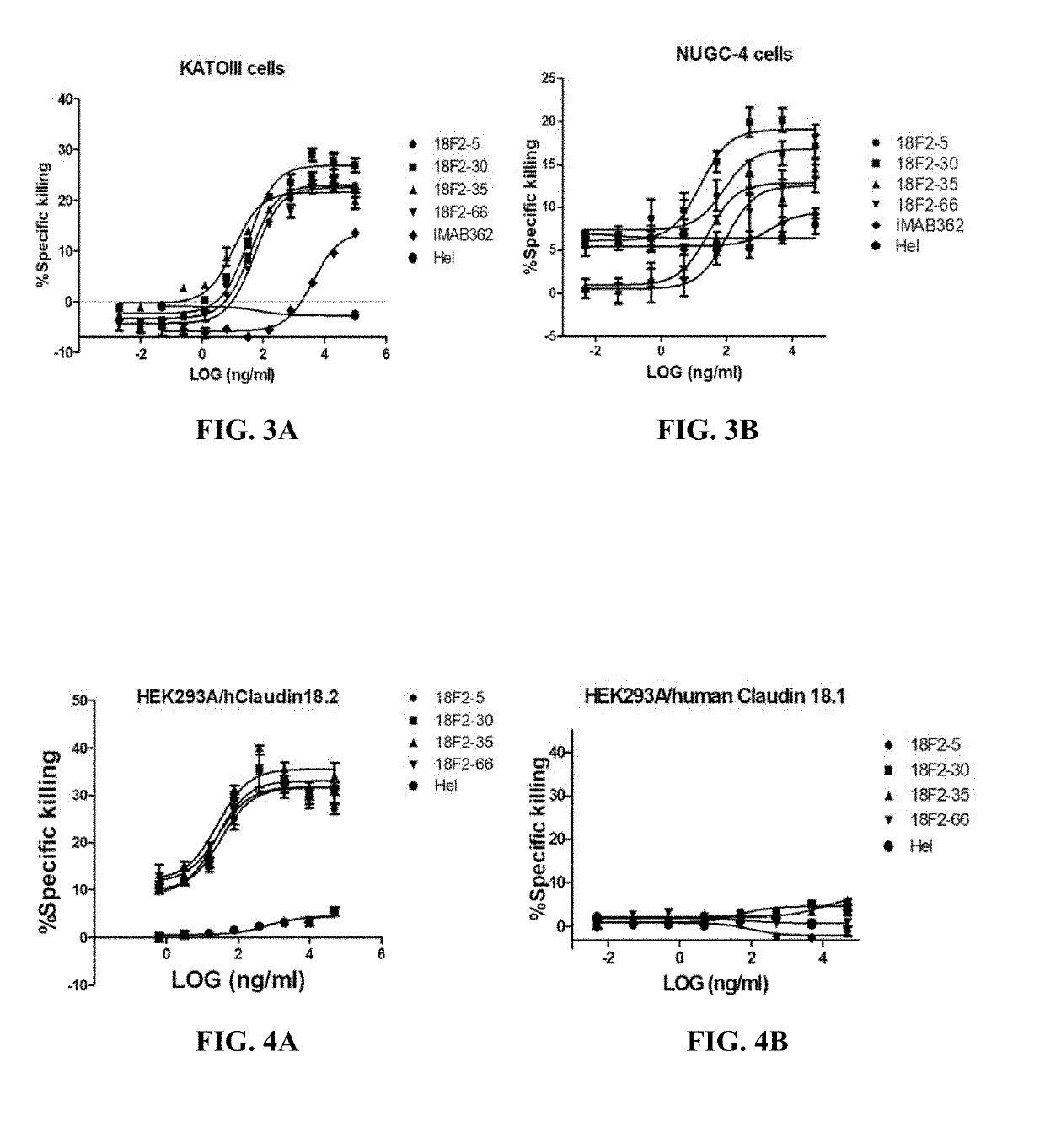Antibodies binding human Claudin 18.2 and uses thereof
a technology of claudin and antibodies, which is applied in the field of antibodies specifically binding to human claudin 18 . 2, can solve the problems of poor prognosis, difficult cure of many cancers, and overall five-year survival rate of gastroesophageal cancer of 20-25%, and achieves claudin 18.2 binding stability, cdc activity, and high adcc activity.
- Summary
- Abstract
- Description
- Claims
- Application Information
AI Technical Summary
Benefits of technology
Problems solved by technology
Method used
Image
Examples
example 1
Construction of HEK293A Cell Lines Stably Expressing Human Claudin 18.1 or Claudin 18.2
[0174]HEK293A cells (Cobioer, China) overexpressing human Claudin 18.1 or Claudin 18.2 were generated by using the lentivirus transfection system. Briefly, cDNA sequences (SEQ ID NOs: 69 and 71) encoding human Claudin 18.1 (SEQ ID NO: 70) and Claudin 18.2 (SEQ ID NO: 72) were synthesized and cloned into pLV-EGFP(2A)-Puro plasmids, respectively, at EcoRI and BamHI sites. Lentiviruses were generated in HEK-293T (Cobioer, China) cells by cotransfection with pLV-EGFP(2A)-Puro-Claudin 18.1 (or pLV-EGFP(2A)-Puro-Claudin 18.2), psPAX2 and pMD2.G plasmids. The obtained lentiviruses were used to infect the HEK293A cells to generate stable cell lines overexpressing human Claudin 18.1 or Claudin 18.2, which were then cultured in DMEM medium (Cat #: SH30022.01, Gibco) with 10% FBS (Cat #: FND500, Excell) and 0.2 μg / ml puromycin (Cat #: A11138-03, Gibco) for more than 7 days.
[0175]The expression of Claudin 18....
example 2
Generation and Screening of Anti-Claudin 18.2 Monoclonal Antibodies
[0176]To generate monoclonal antibodies binding human Claudin 18.2, six-week old BALB / c mice were inoculated with the HEK293A cells stably expressing human Claudin 18.2 (see Example 1). Briefly, mice were subcutaneously injected with 2×107 / ml HEK293A / human Claudin 18.2 cells followed by three boosts in a four-week-interval. Antibody titers in the serum samples were determined by FACS using the HEK293A cells expressing human Claudin 18.2. When the animals reached suitable antibody titers, the mice were given a final immunization boost with 5×107 / mL cells in PBS. Three days later, the mice were euthanized, exsanguinated, and the spleens were harvested for mRNA extraction and phage display library construction.
[0177]To construct a scFv phage display library, the total spleen RNAs of the mice were extracted using Trizol kit (Invitrogen), and cDNAs were synthesized using Reverse Transcriptase Kit (Invitrogen). Gene amplif...
example 3
Expression, Purification and Characterization of Full Length Anti-Claudin 18.2 Monoclonal Antibodies
[0180]Ten selected scFv antibodies were expressed in HEK293F (Cobioer, China) cells as full length monoclonal antibodies for further characterization. Briefly, the expression vectors were constructed by cloning respective heavy / light chain variable region plus the human IgG1 / kappa constant regions (SEQ ID Nos.: 67 and 68) into EcoRI / BamHI of pCDNA3.1 (Invitrogen, Carlsbad, USA).
[0181]Chimeric anti-human Claudin 18.2 antibodies were transiently expressed in HEK-293F cells using PEI transfection according to the manufacturer's manual. Briefly, HEK-293F cells were transfected with the resulting vectors using polyethyleneinimine (PEI) at a DNA:PEI ratio of 1:3. Total DNA used per transfection was 1.5 μg / ml. Transfected HEK-293F cells were cultured in an incubator in 5% CO2 at 37° C. with shaking at 120 RPM. After 10-12 days, supernatants were harvested and monoclonal antibodies were purif...
PUM
| Property | Measurement | Unit |
|---|---|---|
| Length | aaaaa | aaaaa |
| Vickers hardness | aaaaa | aaaaa |
| Vickers hardness | aaaaa | aaaaa |
Abstract
Description
Claims
Application Information
 Login to View More
Login to View More - R&D
- Intellectual Property
- Life Sciences
- Materials
- Tech Scout
- Unparalleled Data Quality
- Higher Quality Content
- 60% Fewer Hallucinations
Browse by: Latest US Patents, China's latest patents, Technical Efficacy Thesaurus, Application Domain, Technology Topic, Popular Technical Reports.
© 2025 PatSnap. All rights reserved.Legal|Privacy policy|Modern Slavery Act Transparency Statement|Sitemap|About US| Contact US: help@patsnap.com



